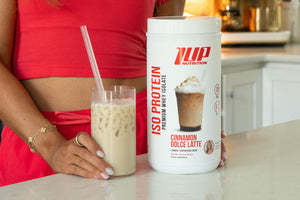For the longest time, fat was viewed as a macronutrient to be avoided, or eaten in extreme moderation. Thankfully, modern studies have shown that fat is not to be feared. It is an essential macronutrient after all, and offers a variety of benefits for the body.
That being said, there are a growing number of cooking oils to choose from, and depending on what you’re cooking and how you’re preparing it, there are better choices than other cooking fats.
Let’s discuss some of the healthiest cooking oils you’ll find on the shelf, and which one is better suited to a particular application.
#1 Olive Oil
We’ll start off this list with the most popular cooking oil -- olive oil.
A staple of the Mediterranean Diet that’s widely regarded for its cardiovascular-support benefits, olive oil is rich in monounsaturated fats as well as numerous polyphenols, antioxidants, and essential vitamins, including Vitamin E and K.
There are several types of types of olive oil you’ll encounter on store shelves, including:
- Light olive oil: Don’t mistake the “light” description for meaning light olive oil is lower in calories than other varieties. It still contains the same amount of calories per gram as every other type of olive oil. Light olive oil means it has a “lighter” flavor than virgin and extra virgin olive oil, due to the fact that light olive oil is a blend of oils, meaning it’s not “pure” olive oil. Due to the blended contents, light olive oil has a higher smoke point than extra virgin olive oil, which may make it better for cooking at higher temperatures and virgin or extra-virgin olive oil. However, there are other oils that are recommended for cooking at high temperatures further down on this list in lieu of light olive oil.
- Pure Olive Oil: contains only olive oil; however, it can include a “blend” of virgin oils (usually between 15-20%) with the remaining 80-85% likely consisting of refined olive oils. Similar to light olive oil, pure olive oil has a lighter taste than extra-virgin olive oil
- Virgin Olive Oil: very similar to extra virgin olive oil, but it is slightly lower in quality. Chances are you won’t see this as regularly in your neighborhood grocery store as EVOO.
- Extra virgin olive oil (EVOO): the least-processed, and our preferred type of olive oil, EVOO is cold-pressed, has a lower level of acidity, and is the highest quality olive oil you can purchase. It is abundant in polyphenols that possess antioxidant and anti-inflammatory properties. However, EVOO also has the lowest smoke point of the various olive oil offerings, and it’s best reserved for use in cooler temperature applications (garnishes, drizzles, salad dressings) or cooking over low heat.
#2 Avocado Oil
Avocado is one of the few fat-forward fruits provided by nature (most fruits contain little-to-no fat at all). In addition to supplying healthy fats, avocados are also rich in fiber, antioxidants, and multiple minerals and vitamins.
In particular, avocado oil contains high amounts of vitamin E and the heart-healthy monounsaturated fat oleic acid. When looking for the best-quality, opt for cold-pressed, unrefined avocado oil as it contains the highest amount of beneficial nutrients and doesn’t have any added fillers (junk).
Avocado oil is great for use in salad dressings or as a garnish over grilled veggies and meats. Due to its high smoke point, it is a better option for cooking at higher temperatures compared to olive oil.
#3 Canola Oil
Hailing from Canada, hence its name of Canola, canola oil is rich in monounsaturated and polyunsaturated fats, including the omega-6 fatty acid linoleic acid. Despite some fear-mongering articles and influencers the past few years, canola is not something that is to be feared as omega-6 fatty acids are one of the body’s essential fatty acids. The important thing is to make sure you’re consuming sufficient amounts of omega-3 fatty acids each day as well (from fatty fish, walnuts, or omega-3 supplements).
It is a heart-healthy oil and has been found in systematic reviews and meta-analyses (a “study of multiple research trials”) to improve total cholesterol and LDL (“bad”) cholesterol compared to other fats, including sunflower oil.[1,2] Additionally, the phytonutrients contained in canola oil are also known to offer anti-microbial, anti-inflammatory, anti-obesity, anti-diabetic, anti-cancer, neuroprotective, and cardioprotective benefits.[2]
Canola oil has a high smoke point and is suited to cooking at medium to high temperatures, and since it has a neutral flavor, can be used for stir-frying, sauteing, grilling, or roasting meats, fish, vegetables, and mushrooms.
#4 Coconut Oil
Compared to the other three oils we’ve discussed so far, coconut oil is rich in saturated fats, which at one time was considered a “bad” fat. As with everything in life, things aren’t always so black and white. Saturated fats are needed for hormone production and various other biological processes, so consuming at least some each day is necessary.
The important thing to keep in mind is to consume a balance of saturated fats (e.g. coconut oil or butter) and unsaturated fats (omega-3s, omega-6s, etc.)...in addition to regular exercise, quality sleep, stress management, and maintaining a healthy body composition.
Coconut oil It’s also become a hugely popular source of fat in the keto and paleo communities over the past decade or so for its MCT content, which supports the body’s production of ketones. It has a smoke point ~375–400°F, and can be used to saute’/stir-fry veggies and proteins, amp up the flavor in curries or replace some or all of the butter in certain baking recipes.
#5 Safflower Oil
Made from seeds of the safflower plant, safflower oil is neutral-tasting and low in saturated fat. It also has a higher smoke point (~510°F), making it a better option for high-heat cooking (roasting, sauteing, grilling, etc.). With its neutral flavor, safflower oil can also be used for sauces, dips, marinades, and salad dressings
Takeaway
There are many different types of cooking oils on the market. The one with the most research-backed benefits for human health is olive oil; however, it shouldn’t be used for high-heat cooking applications. Olive oil is best suited for dips, dressings, and sauces.
Also remember, that it is important to consume enough dietary fat as it is an essential macronutrient the body needs for cellular health, hormone production and joint health. If you’re not sure how much fat is recommended for your body each day, check out the 1UP Fitness App where you can get customized nutrition plans and macronutrient targets to aim for each day so that you can continue to perform better, recover faster, and get the results you want!
References
- Ghobadi S, Hassanzadeh-Rostami Z, Mohammadian F, Zare M, Faghih S. Effects of Canola Oil Consumption on Lipid Profile: A Systematic Review and Meta-Analysis of Randomized Controlled Clinical Trials. J Am Coll Nutr. 2019 Feb;38(2):185-196. doi: 10.1080/07315724.2018.1475270. Epub 2018 Oct 31. PMID: 30381009.
- Shen, J.; Liu, Y.; Wang, X.; Bai, J.; Lin, L.; Luo, F.; Zhong, H. A Comprehensive Review of Health-Benefiting Components in Rapeseed Oil. Nutrients 2023, 15, 999. https://doi.org/10.3390/nu15040999






